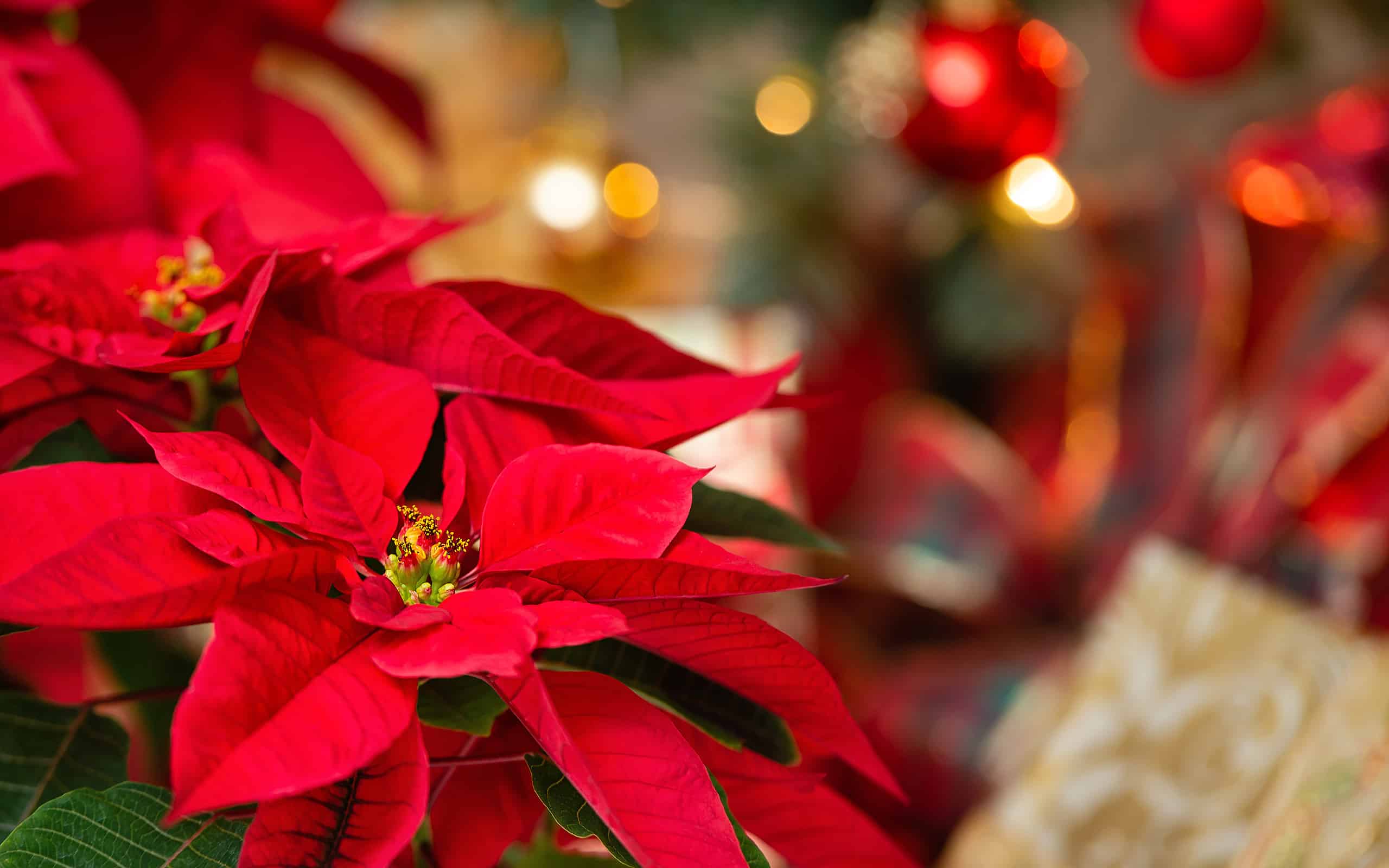Bright red and green poinsettias have been the symbolic plants of Christmas for hundreds of years. They first appeared in the U.S. when American statesman Joel Poinsett sent some back from Mexico to his home state of South Carolina. Along with being the first U.S. minister to Mexico, Poinsett was a botanist who was intrigued by the unusual shrubs he saw along the side of the road.
Known scientifically as Euphorbia pulcherrima, these unique plants are now commonly named after the man who first brought them to the U.S.
While bright red poinsettias can be purchased almost anywhere during November and December, many people don’t realize the variety of colors in which these plants come. This is due to their distinct plant pigments called anthocyanins.
While we think of the colorful parts of poinsettias as flowers, they are actually a type of leaf called a bract. If you look closely, you’ll see the true small flowers in the center of the bracts. These little yellow buds go by the name “cyathia.”
Here are some of the gorgeous hybrid hues poinsettias can be found in, from the rarest to the most common.
1. Orange
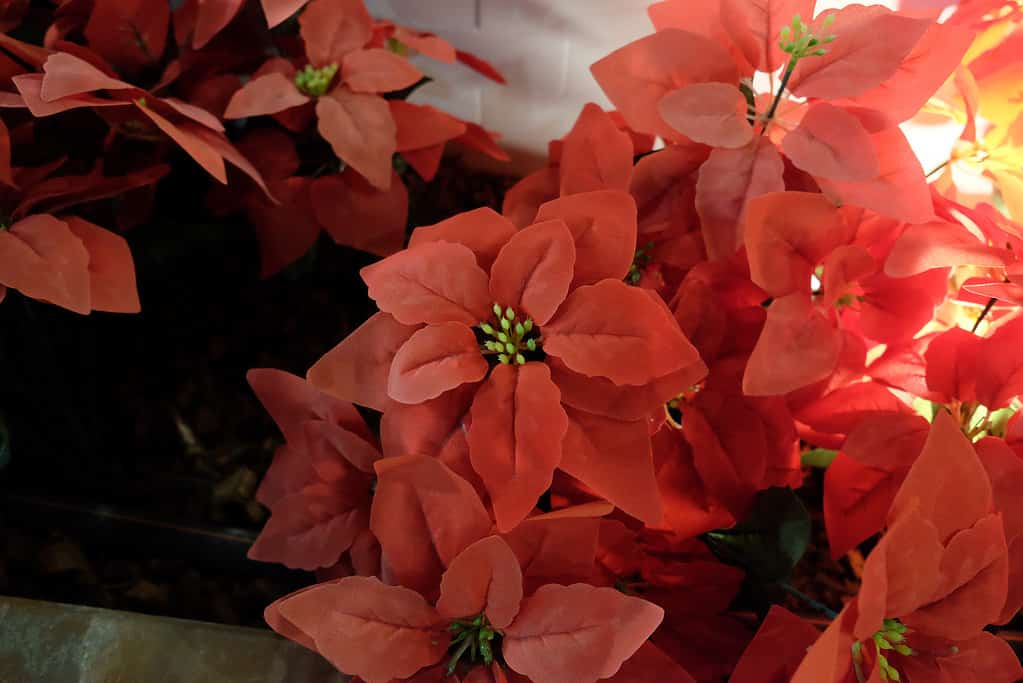
While traditional red poinsettias are holiday classics, a spectacular range of orange varieties have been cultivated.
©Oleksii Kononenko/iStock via Getty Images
Orange poinsettias are cultivated under a variety of names, such as Harvest Orange, Autumn Leaves, and Orange Spice. The colors range from pastel to bright orange. The cultivar named “Orange Glow” is especially brilliant.
2. White
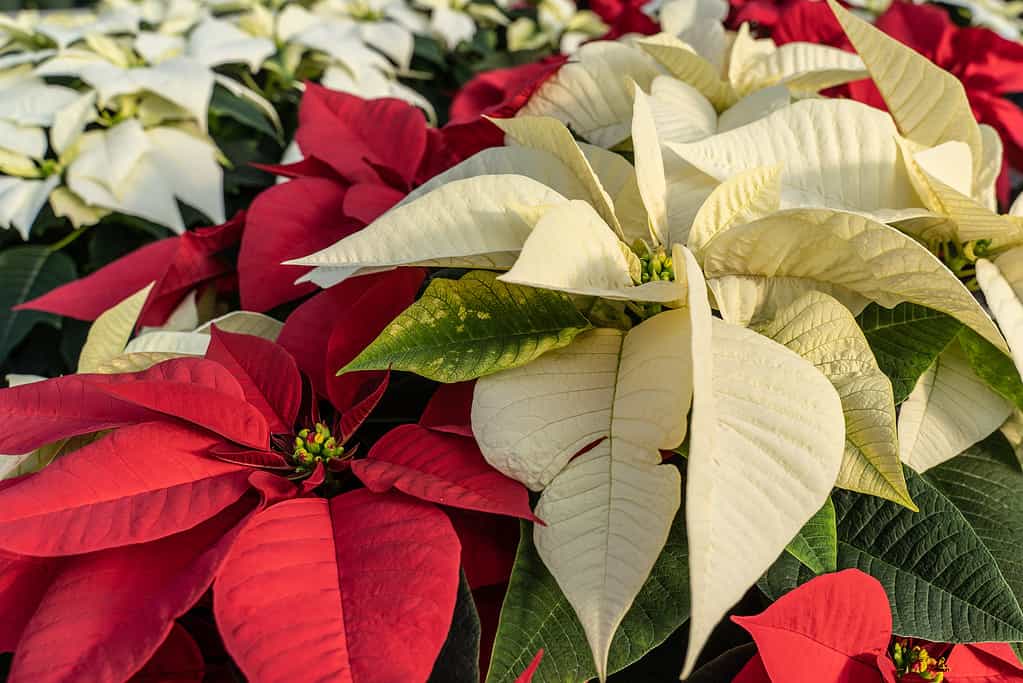
True white poinsettias are not easy to find, with most being cream or beige-colored.
©arlutz73/iStock via Getty Images
While it’s common to see a bone-colored or cream-white poinsettia, cultivating perfectly white ones has been elusive. Several years ago a company in the Netherlands called Princettia came up with a variety called Pure White, claiming to be the very first to develop bracts of that shade, which are contrasted by their dark green leaves.
3. Pink and Cream

Poinsettias with variegated bracts come in red and white and pink and yellow combos.
©Goroda/iStock via Getty Images
Cultivated under the name “Winter Rose Marble” this spectacular plant has a streak of soft pink running down its eggnog-colored bracts, which are beautifully crinkled.
Once thought of as weeds, poinsettias are now the biggest-selling potted plant in both the U.S. and Canada.
4. Shades of Pink

In their native habitat, poinsettias are tall-shrub-like plants, that have little resemblance to the compact pot-bound varieties found in stores.
©GomezDavid/iStock via Getty Images
Pink varieties include bright neon, pink with white flecks, marbled and soft pinks, blushing pink with white, and yellow and pink bract shades.
The Euphorbia genus consists of a wide variety of plants. All of these unique new colors, as well as the compact nature of the plant itself, are the result of cross-breeding with the traditional poinsettia pulcherrima species.
5. Green
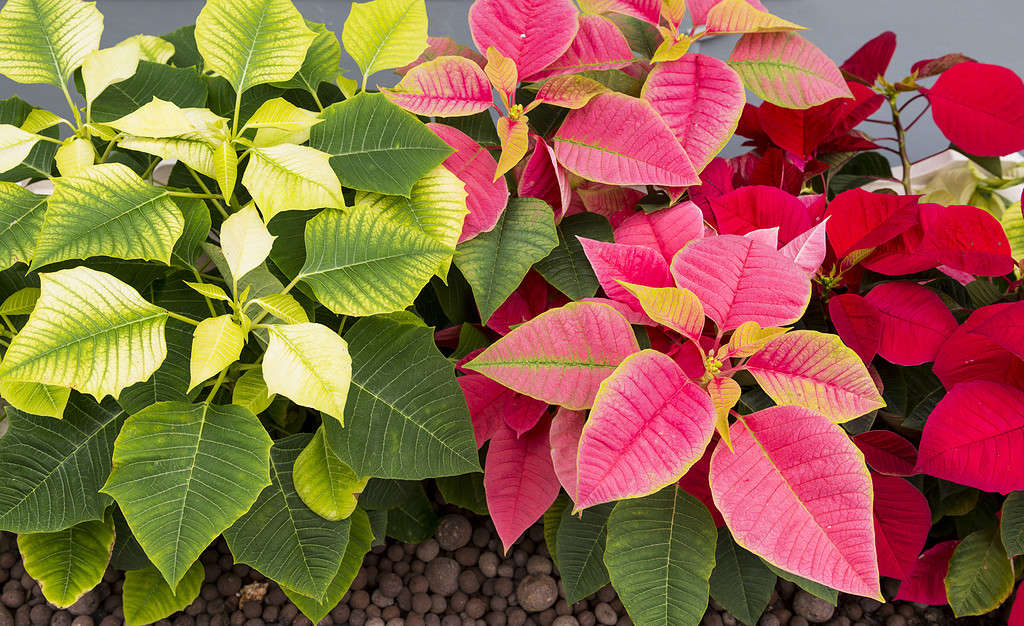
Green poinsettias are the latest color to be created through genetic manipulation.
©Kwun Kau Tam/iStock via Getty Images
Developed by the Dutch company Dummen Orange under the name “Green Envy,” this is said to be the first green or chartreuse (yellow-green) poinsettia ever cultivated.
Poinsettias are not propagated by seed, but rather cuttings. Leaves are cut and then dipped into rooting hormone. They are rooted directly into a container or in a media such as peat and perlite. It should be noted that it’s illegal to propagate varieties such as this, which are still protected by patents.
6. Salmon

Poinsettias are not propagated by seed, but rather cuttings that are grown in greenhouses.
©Евгений Харитонов/iStock via Getty Images
Going by names such as “Viking Cinnamon,” “Marco Polo,” and “Ice Punch,” these salmon reds are visually striking hybrids.
Although poinsettias can be cultivated in a seemingly unlimited variety of shades, there are no natural blue or purple ones. Any of those colors have been spray-painted to achieve that hue. And despite the brilliant natural colors available, glitter is often sprayed on the bracts for a fake sparkly look.
7. Curled Rose
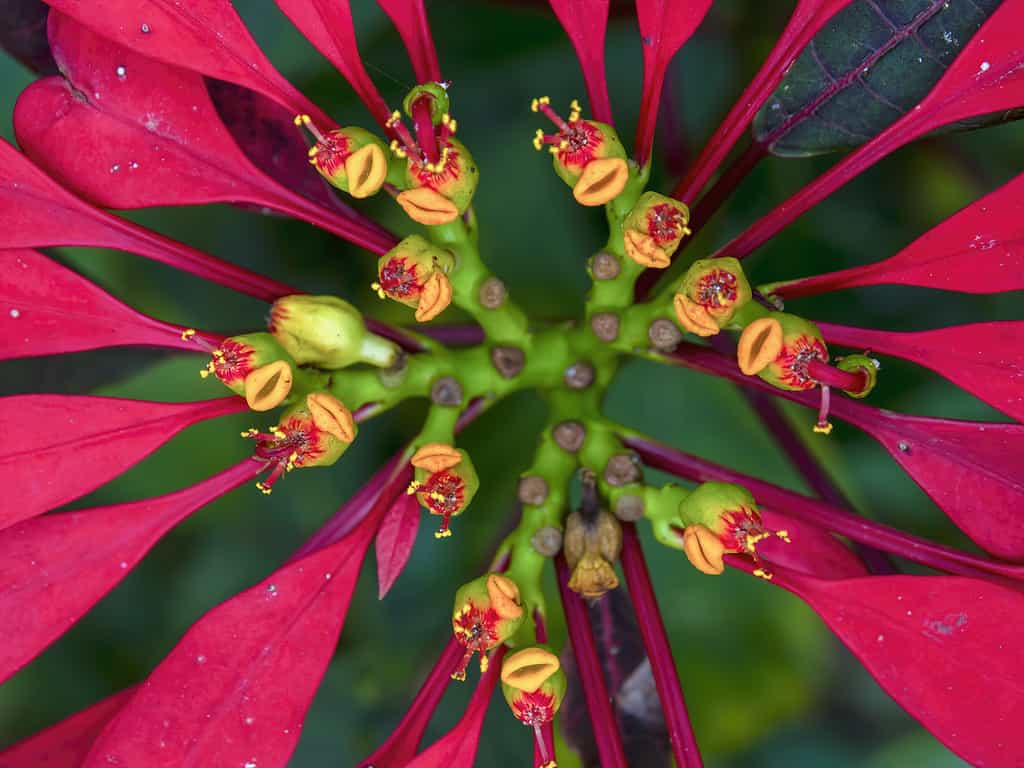
Poinsettia flowers are in the center of the bracts. These little yellow buds go by the name “cyathia.”
©Mauricio Acosta/iStock via Getty Images
Similar in color to the traditional red poinsettia, this dark-red hybrid sports a curled bract, somewhat like a rose petal. Cultivated under several names it goes under the heading in botanical circles of “novelty red.”
At one time the king of poinsettias was the Ecke Ranch in Encinitas, California. Paul Ecke Sr. was famous for traveling around the U.S. with a suitcase full of poinsettia cuttings giving horticulturalists lessons in propagating them. Later, his son, Paul Ecke Jr. did his part in making the festive plant synonymous with the holiday season in the 1960s by decorating the sets of popular TV shows with poinsettias. In the day, the Eckes were considered the biggest suppliers of poinsettia genetics holding numerous patents.
8. Holiday Reds
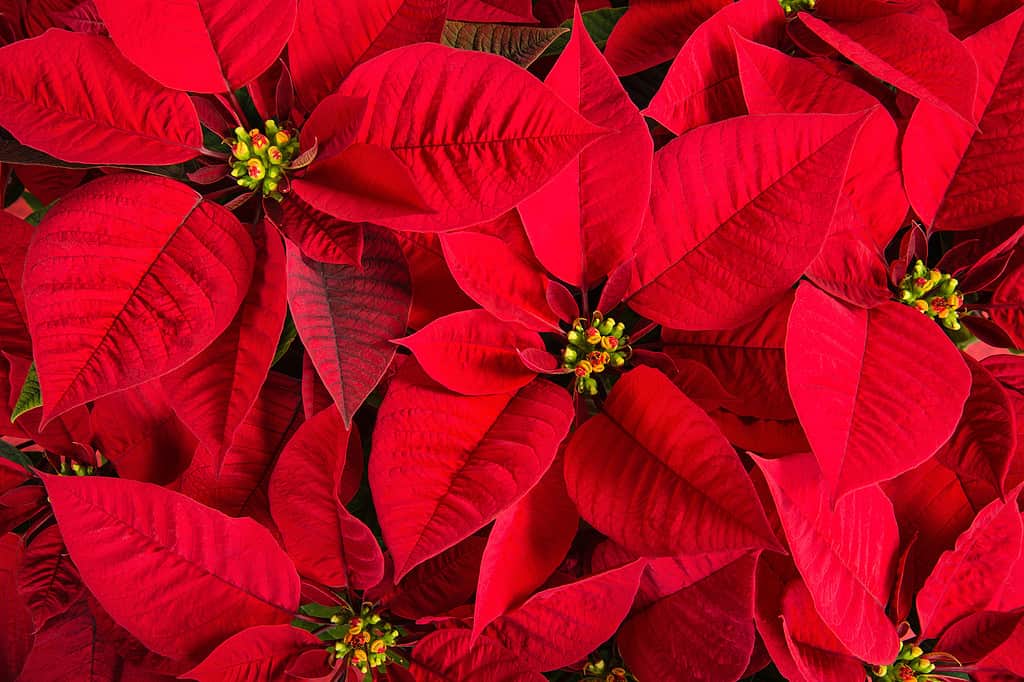
In the world of poinsettias, there are many shades of red.
©leekris/iStock via Getty Images
The most popular and commonly sold colors are, of course, the reds. But even in this shade, these cheery plants have numerous varieties.
There’s “Valentine,” a hybrid with curled rose-petal-like bracts that make it unique. The classic holiday color and look is also represented in variations such as “Prestige Red” and Early Orion Red.” If you want to decorate as they do at the Biltmore Estate in Asheville, North Carolina, choose “Advent Red,” a brilliant red hue with classic green leaves.
In their native habitat, poinsettias are tall-shrub-like plants. The colorful red bracts grow at the ends of a long stalk with widely spaced green leaves growing down the stalk to the base. Basically, except for the familiar bracts, they bear little resemblance to what’s sold in the supermarket or garden store.
Poinsettia Pointers
Even though these plants are associated with the winter season, remember, they originally came from Mexico! The most common problem, dropping leaves, is usually caused by being placed too near a window or in a drafty part of the house.
They can be so finicky regarding temperature variations that even when bringing them home, be sure to protect the plant from cold conditions. Another reason poinsettias may drop their leaves is if you let them dry out. Keep them evenly moist with exposure to bright light for at least six hours a day. They do best in temperatures between 65 and 70 degrees Fahrenheit.
Not So Toxic After All
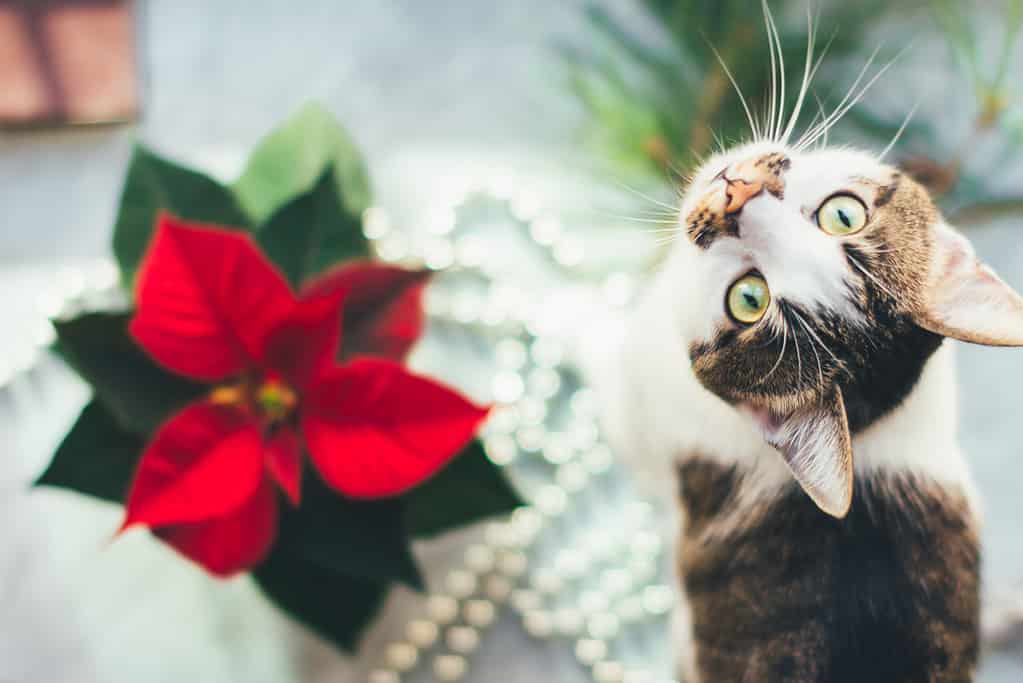
Poinsettias are not edible, but they’re not highly toxic either.
©Anna_Hirna/iStock via Getty Images
One long-lasting myth is that poinsettias are extremely toxic, especially to pets. They do have a milky sap that is a mild irritant, but they are not considered particularly toxic if eaten in small amounts.
Veterinarians say that a dog or cat can experience some drooling or vomiting after consuming the flowers or stems, but that it’s typically limited, and rarely calls for medical treatment.
Thank you for reading! Have some feedback for us? Contact the AZ Animals editorial team.

